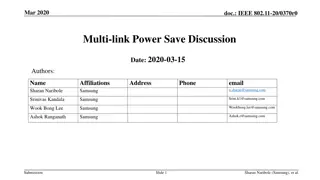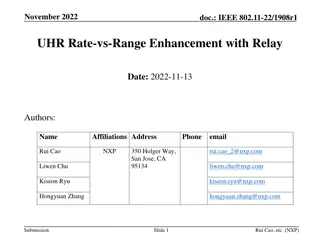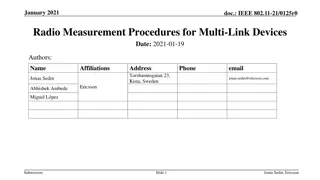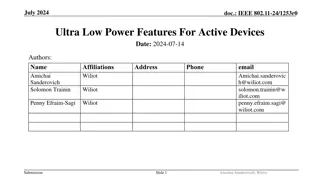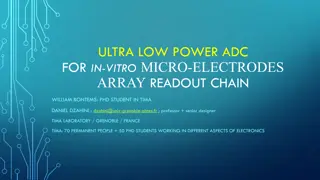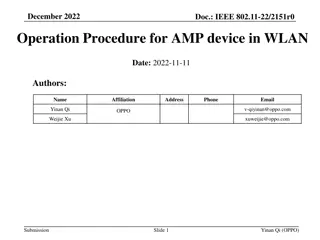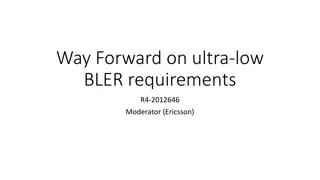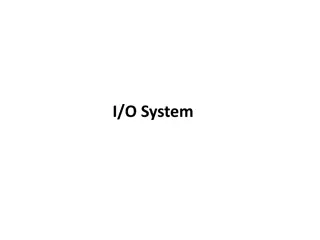Considerations for Ultra-Low Power AMP Devices in IEEE 802.11-23 Standard
This document discusses key considerations for designing ultra-low power and low-complexity energy harvesting based AMP-STAs within the IEEE 802.11-23 standard. It highlights limitations related to energy reserves, ambient power, and clock generation for active transmitters. The analysis emphasizes the importance of optimizing external components and reducing clock accuracy requirements to enhance efficiency while maintaining cost-effectiveness.
Download Presentation

Please find below an Image/Link to download the presentation.
The content on the website is provided AS IS for your information and personal use only. It may not be sold, licensed, or shared on other websites without obtaining consent from the author. Download presentation by click this link. If you encounter any issues during the download, it is possible that the publisher has removed the file from their server.
E N D
Presentation Transcript
July 2023 doc.: IEEE 802.11-23/1140r0 Considerations for AMP Devices Date: 2023-07-10 Authors: Name Amichai Sanderovich Affiliations Wiliot Address Phone email Amichai.sanderovich@wiliot. com sagi.kupferman@wiliot.com Sagi Kupferman Wiliot yuval.amran@wiliot.com Yuval Amran Wiliot Submission Slide 1 Amichai Sanderovich, Wiliot
July 2023 doc.: IEEE 802.11-23/1140r0 Abstract We present an analysis for several limitations that should be considered when designing a standard for an ultra-low power and low-complexity energy harvesting based AMP-STAs These are not physical or mathematical limitations, but rather some common, current technology features that were found by our analysis with significance to AMP-STAs We suggest to take such analysis into consideration when chosing between several options for the AMP standard Submission Slide 2 Amichai Sanderovich, Wiliot
July 2023 doc.: IEEE 802.11-23/1140r0 Ambient Power STAs Have Small Energy Reserves For AMP-STAs, energy is extremely limited Very small battery (e.g. printed 30-80mAh) Scarce light conditions (PV within building or on a very cloudy day) Small capacitor for RF energy harvester (nJ-uJ) An example of a transmission of 30us with EIRP=-10dBm: The energy spread to the air = 3nJ Actual devices are usually less efficient and energy consumption of 30nJ is reasonable AMP-STAs are ultra-low complexity as well as ultra-low power In order to fit cost and size of sticker form factor, requirements for several external components should be limited This is especially true for external components that consumes energy Submission Slide 3 Amichai Sanderovich, Wiliot
July 2023 doc.: IEEE 802.11-23/1140r0 Impact of Clock Generation for an Active Transmitter AMP-STA For active transmitter AMP-STAs, we would like to reduce the need for a stable clock with accuracies in the orders of 40ppm Stable crystal-based clocks usually consume non-neglectable power and also take some time to turn on, until reaching stability In addition, they require an external component on top of the silicon chip. This increases the bill of matrial (BOM) of the product and also limits massive deployments with a sticker form factor Depending on exact system design, it is possible to use a simpler, lower power, internal oscilators [1- 3]. Such oscilators are usually characterized with lower clock accuracies. However, by using various low power calibrations, they can reach an accuracy of 1000ppm We recommend to reduce the clock accuracy required from an AMP-STA to 1000ppm The AMP-AP clock accuracy can still hold the 802.11-2020 clock accuracy requirement as it is not required to be ultra-low complexity or ultra-low power Submission Slide 4 Amichai Sanderovich, Wiliot
July 2023 doc.: IEEE 802.11-23/1140r0 Impact of Memory Retention AMP-STAs are required to support energy harvesting power delivery. This means these devices are not always powered on, and most of the time are either powered off or work on the remaining energy from last energizing One of the biggest energy cosuming blocks is the memory. While on dynamic power regime, the memory power consumption is comaparable to the rest of the circuitry operating within the AMP-STA. But while staying non-active/standby (meaning no transmit or receive) any requirement to retain memory values is energetically expensive - especially if this is required for long times [4]. Various SRAM technologies with low retension power consumption exist, but between 20- 200fW/bit are achievable in commercial products. So, holding 1Kbyte for 1 minute takes 10nJ, which is comparable to the transmission energy. Submission Slide 5 Amichai Sanderovich, Wiliot
July 2023 doc.: IEEE 802.11-23/1140r0 Impact of Non-Volatile Memory An alternative to retaining memory is the use of a non-volatile memories. One such component is OTP, which allows for a device to write once, and then read multiple times. This component can be integrated into the Si, without the need to increase complexity of end-device. Between the write and the read there is no need for energizing, and the written values stay written without any energy consumption. However, it is basically a one-time write, so multiple writes can be done only a few predetermined times. Our analysis revealed that such component can consume as much as 50-500uJ per writing of 32 bits. This is orders of magnitude more energy compared to the energy used by the transmission. Submission Slide 6 Amichai Sanderovich, Wiliot
July 2023 doc.: IEEE 802.11-23/1140r0 Impact of Idle/Wait Times While the AMP-STA is non-active, during either idle or wait times, it is desirable that the device will consume the minimum amount of energy possible. Since these times can be much longer than active times (depending on the system architecture), the power cosumption during these times is non-neglegable. For Example, by using a lower accuracy clock, we can minimize energy consumption. This clock can be used for either operating a low power receiver (WUR) or as a synchronizer for waking up. Our analysis suggests that such clock can operate with an accuracy of 10,000ppm for a 100KHz clock [2]. Submission Slide 7 Amichai Sanderovich, Wiliot
July 2023 doc.: IEEE 802.11-23/1140r0 Summary An analysis for few possible limitations for AMP-STAs was presented Only mainstream technology was analyzed on each of the suggested parameters, so these limitations can be further updated We suggest to consider these limitations when compering between different options for adoption in the standard By limiting the requirements from an AMP-STA according to the analysis, AMP-STAs can reach lower cost and be based on energy harvesting. Additionally, it will provide significant diffrentiation from devices implementing other existing low power standards. Submission Slide 8 Amichai Sanderovich, Wiliot
July 2023 doc.: IEEE 802.11-23/1140r0 References 1. Wheeler et. al., Crystal-Free Narrow-Band Radios for Low-Cost IoT, 2017 IEEE Radio Frequency Integrated Circuits Symposium. 2. Jiang et al, A 0.4-V 0.93-nW/kHz Relaxation Oscillator Exploiting Comparator Temperature-Dependent Delay to Achieve 94-ppm/ C Stability, IEEE JOURNAL OF SOLID-STATE CIRCUITS, VOL. 53, NO. 10, OCTOBER 2018 3. McCorquodale et al, A 25-MHz Self-Referenced Solid-State Frequency Source Suitable for XO-Replacement, IEEE TRANSACTIONS ON CIRCUITS AND SYSTEMS I: REGULAR PAPERS, VOL. 56, NO. 5, MAY 2009 4. J. Kwong, et al, A 65 nm sub-Vt microcontroller with integrated SRAM and switched-capacitor DC-DC converter, in IEEE Int. Solid- State Circuits Conf. (ISSCC) Dig. Tech. Papers, 2008, pp. 318 319. Submission Slide 9 Amichai Sanderovich, Wiliot









